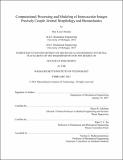Computational processing and modeling of intravascular images precisely couple arterial morphology and biomechanics
Author(s)
Olender, Max Louis.
Download1252630531-MIT.pdf (15.75Mb)
Other Contributors
Massachusetts Institute of Technology. Department of Mechanical Engineering.
Advisor
Elazer R. Edelman.
Terms of use
Metadata
Show full item recordAbstract
Cardiovascular diseases, and coronary artery disease in particular, remain a persistent devastating and prevalent menace to health and wellbeing globally despite great strides in vascular biology and medicine. While biomechanical forces are known to play a driving role in the natural history of atherosclerosis, the nuanced yet profound impact of patient- and lesion-specific biomechanics in disease presentation, course, and treatment are not fully appreciated or accounted for in clinical practice. The incredible strides in melding image processing with artificial intelligence, computational modeling, and numerical methods is increasingly filling gaps in knowledge, especially at the intersection of pathological anatomy and biomechanical structural behavior. We derived geometric and morphological structure, as well as constitutive material properties, from invasive intravascular image sequences to quantitatively assess and characterize the state of atherosclerotic arteries. Overcoming the challenge of limited penetration depth in the presence of signal-attenuating plaque, contextual information and spatial continuity was leveraged by a novel surface fitting method to fully delineate the mural conformation of the diseased vessel wall. Neural networks enriched with domain knowledge of vascular geometry and imaging classified pathological regions of interest within heterogeneous lesions. Construction of in silico computational models and in vitro phantom models facilitated the execution and validation of inverse methods to determine material constitutive mechanical properties non-destructively and in clinically amenable fashion. Strategic simplifying assumptions freed the approach from data acquisition limitations which inhibited previous methods of in situ mechanical characterization. Finally, to bridge the chasm between virtual and physical medicine and facilitate integration of these new capabilities into clinical practice, synthetic images were generated by an adversarial network trained in the familiar visual vernacular of vascular imaging. Through the insights described in this thesis, greater information can be extracted, augmented, and made accessible from clinically-available imaging data. Approaches to more quantitatively and reliably assess, model, and convey biomechanical disease states may offer mechanistic insight into disease development, progression, and treatment response, ultimately leading to improved personalized patient care in an emerging era of computational cardiology.
Description
Thesis: Ph. D., Massachusetts Institute of Technology, Department of Mechanical Engineering, February, 2021 Cataloged from the official PDF of thesis. Includes bibliographical references (pages 279-301).
Date issued
2021Department
Massachusetts Institute of Technology. Department of Mechanical EngineeringPublisher
Massachusetts Institute of Technology
Keywords
Mechanical Engineering.